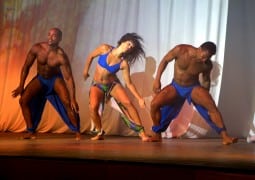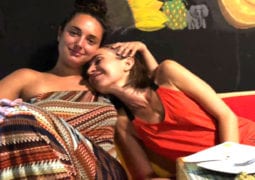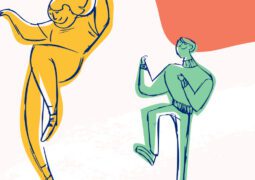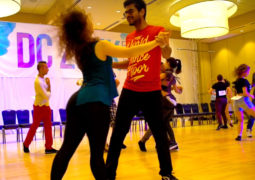The Breakup with Your Dance Partner

🇺🇸 EN
There’s something almost no one talks about in the dance world: what it really means to break up with your dance partner.
It might sound simple, like “just changing partners.” But inside, it’s so much more than that. It’s a real breakup, with all the pain, emptiness, and grief that comes with it.
I lived it.
About seven years ago, I met someone in my group classes. He was an advanced student, and the first time we danced together, it was an immediate wow: an incredible connection. Little by little, we became friends, went out dancing, and since I didn’t have a partner at that time, I asked him to team up with me.
He was the visionary, full of ideas and dreams. I was the builder, the one who organized and structured. That combination worked: he dreamed, I grounded, and together we became a strong team.
Our daily life was intense. Every morning, the first thing I did was text him: “What’s the plan today?” We trained two or three hours a day, prepared classes, shows, traveled. Most of the time, he was the first person I saw every day. And the most beautiful thing: with him, I could be 100% myself, no filters. That freedom and complicity were what I cherished the most.
But then came exhaustion. Our projects weren’t working out the way we wanted, and my visionary burned out. He lost his energy and motivation, and I didn’t have the tools to support him. That’s when things began to crack, until it all ended.
The pain was immense. I felt like I had failed: failed him, failed myself, failed the community we were serving together. The hardest part was losing the closest person I’ve ever had in my life. To go from talking every day, training, traveling, laughing, even fighting together… to nothing. The emptiness was overwhelming.
How did I cope? By escaping. I distanced myself from the community and everything we had built. I felt I needed time with myself, to reconnect, to learn, to grow. And I’m still in that process: remembering that I don’t need to depend on someone else to create, that I can also be the visionary, that I am a complete artist even without a partner.
What this experience taught me is that dance partnerships can be a huge source of support, but they can also turn into relationships of dependence. And when they break, it hurts deeply.
That’s why I wanted to share this. Because even though it’s not a romantic breakup, it is still a breakup. It is grief. And even if not everyone understands, those of us who have lived it know how heavy it can be.
And if you’re going through it too, I want you to know you’re not alone. We can rebuild ourselves, we can keep creating and serving from our individuality. And if another person comes along, may it be to add to us, not to complete us.
🇨🇴 ESP
Hay algo de lo que casi nadie habla en el mundo del baile: lo que significa terminar con tu pareja de baile.
Suena simple, como “cambiar de socio”, pero por dentro es mucho más que eso. Es un verdadero breakup, con todo el dolor, el vacío y el duelo que trae.
Yo lo viví.
Hace unos siete años conocí a alguien en mis clases grupales. Era alumno avanzado, y la primera vez que bailamos fue como un “wow” inmediato: una conexión increíble. Poco a poco nos hicimos amigos, salíamos a bailar juntos y, como yo no tenía pareja de baile en ese momento, le propuse formar equipo.
Él era el visionario, lleno de ideas y sueños. Yo era la constructora, la que organizaba y estructuraba. Esa mezcla funcionaba: él soñaba y yo aterrizaba. Y juntos nos volvimos un gran equipo.
Nuestro día a día era intenso. Lo primero que hacía cada mañana era escribirle: “¿qué hacemos hoy?”. Entrenábamos dos o tres horas diarias, preparábamos clases, shows, viajábamos. La primera persona que veía en mi día casi siempre era él. Y lo más bonito: con él podía ser 100% yo, sin filtros. Esa libertad y complicidad eran lo que más disfrutaba.
Pero llegó el cansancio. Nuestros proyectos no estaban saliendo como queríamos, y él, mi visionario, se quemó. Perdió la energía y la motivación, y yo no tuve las herramientas para sostenerlo. Ahí todo empezó a fracturarse, hasta que se acabó.
El dolor fue grande. Sentí que había fallado: a él, a mí misma y a la comunidad que servíamos juntos. Lo más duro fue perder a la persona más cercana que he tenido en mi vida. Pasar de hablar todos los días, de entrenar, viajar, reír y hasta pelear, a no tenerlo más ahí… fue un vacío enorme.
¿Cómo lo llevé? Escapando. Me alejé de la comunidad y de lo que habíamos construido. Sentía que necesitaba tiempo conmigo, volver a encontrarme, aprender, crecer. Y estoy en eso: en el proceso de recordar que no necesito depender de alguien para crear, que yo también puedo ser visionaria, que soy una artista completa incluso sin pareja.
Si algo me dejó esta experiencia es que las parejas de baile son un gran apoyo, pero también pueden convertirse en una relación de dependencia. Y cuando se rompe, duele mucho.
Por eso quería escribir esto. Porque aunque no sea un breakup romántico, sí es un breakup real. Sí es un duelo. Y aunque no todo el mundo lo entienda, quienes hemos pasado por ahí sabemos lo fuerte que puede ser.
Y si tú también lo estás viviendo, quiero que sepas que no estás solo. Podemos reconstruirnos, podemos seguir creando y sirviendo desde nuestra individualidad. Y si llega otra persona, que sea para sumar, no para completarnos.
About: Sindi Obando
- Previous Why Advanced Dancers Don’t Want to Dance With Beginners, And Why That’s Okay
- Next Lasting Love in Social Dance… or Are We Doomed to Drama?
You may also like...
Sorry - Comments are closed







